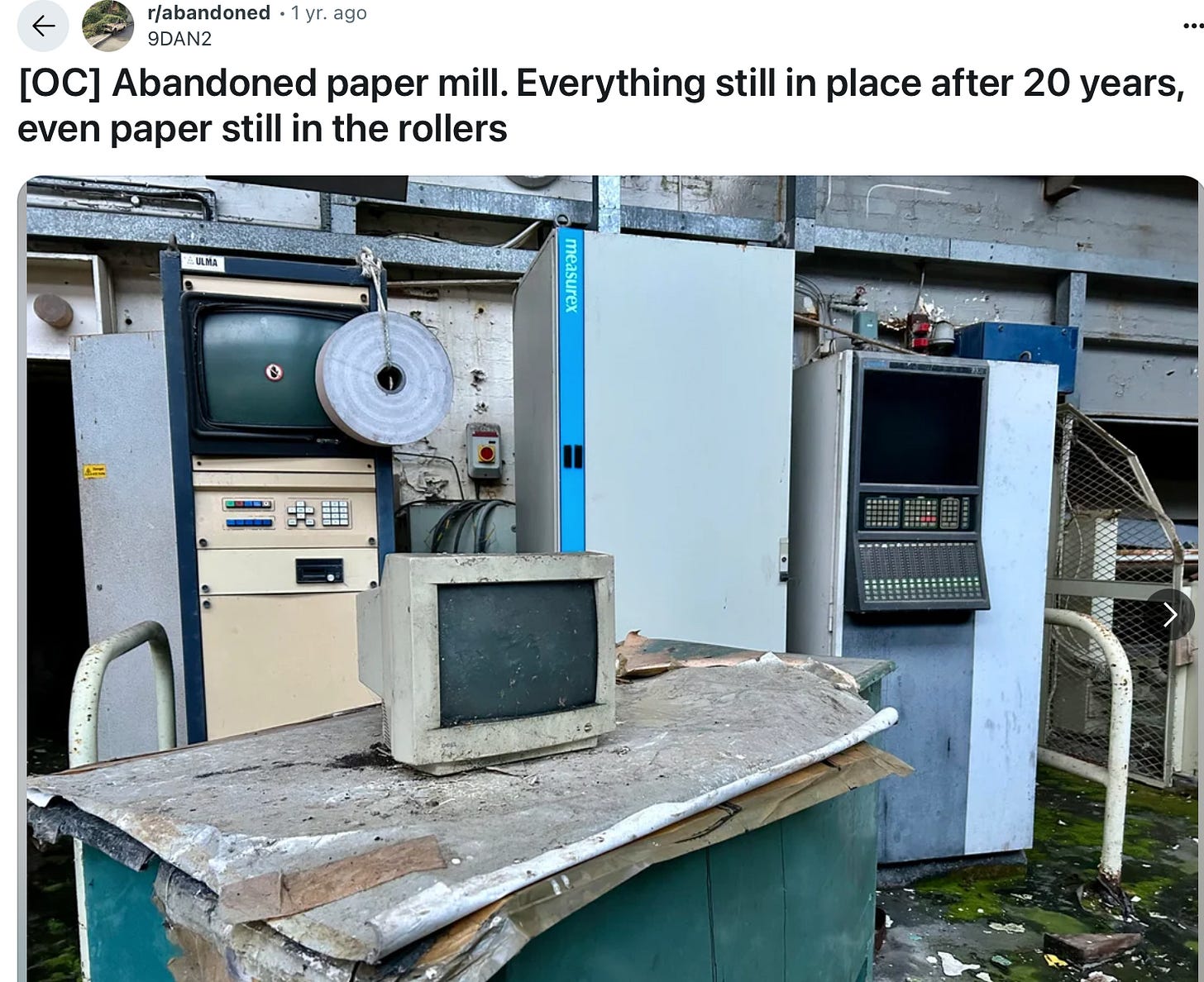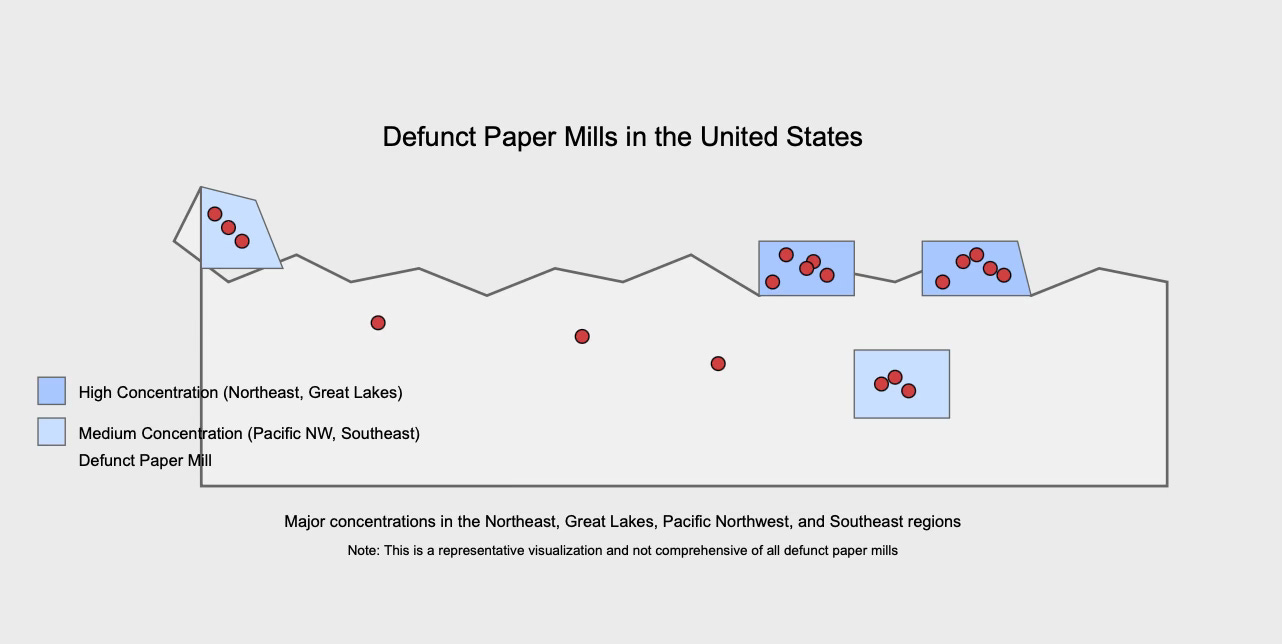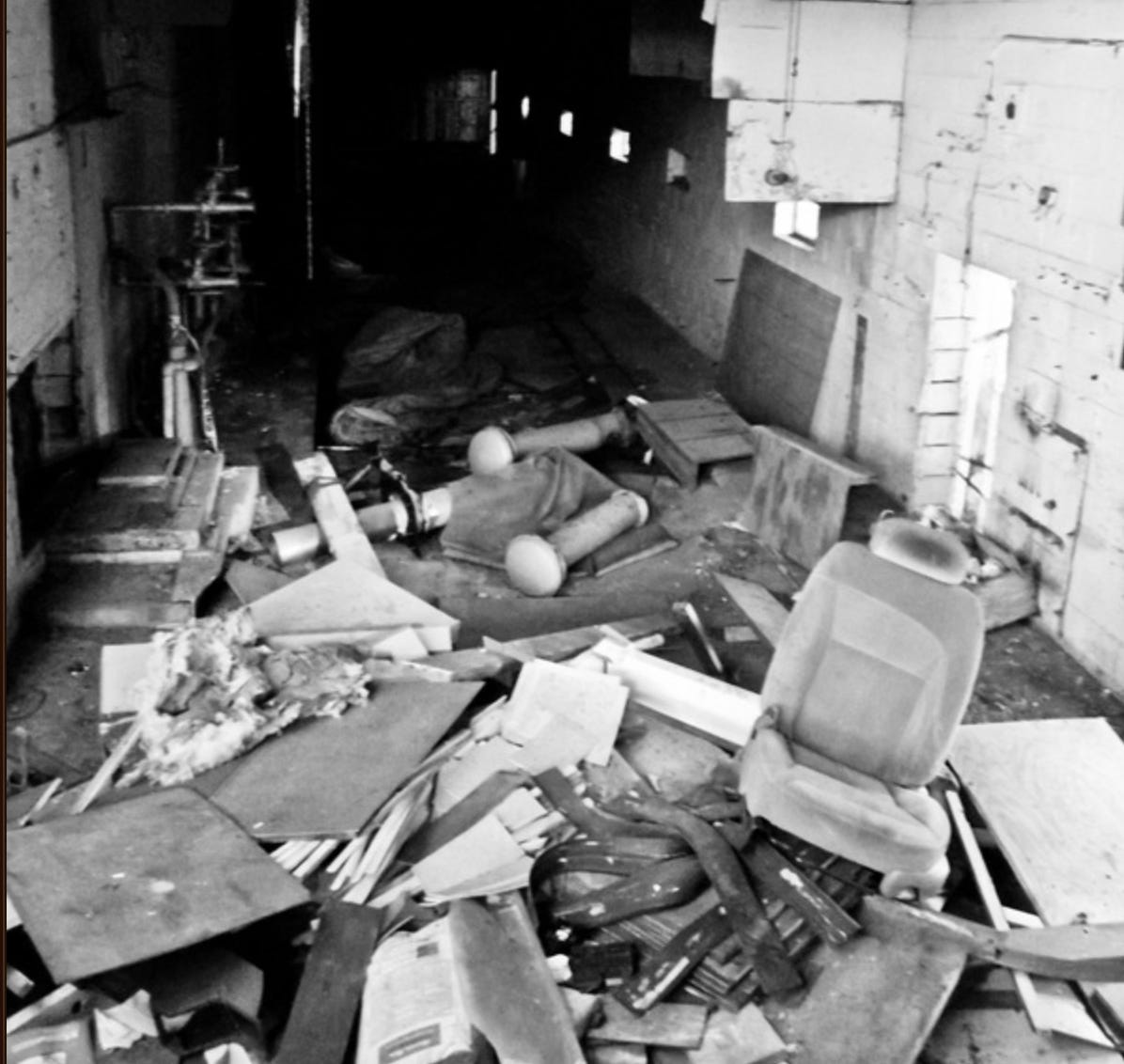During my decade plus writing and publishing about the Rust Belt, I have spent many hours indulging in one of my possibly unfortunate hobbies: staring and thinking about industrial ruins (aka ruin porn); I even have an abandoned Substack about it).
One active and inventive subgenre of ruin porn revolves around abandoned paper mills. Only a few keystrokes will take you to endless videos, photos, photo spreads, reddit forums, and architectural writing. If you want to learn more about them, Wikipedia has an entry for “Defunct pulp and paper companies.”
If you ask Claude, you can get a rather hilarious maps of where all the defunct mills are in the US (can you find the Great Lakes concentration?).
(Claude will also tell you that the US both imports and exports paper, and its main trading partners are Canada (by far the largest) and China.)
What happened to all those paper mills? What is happening to them now? Apart from the larger narrative that explains the word “rust” in the Rust Belt (must we rehearse it yet again? I think we know the story by now. If not, Belt has many books that explain it!) (fine, a footnote1), the more recent answer is private equity. Many mills have been bought recently by such firms, many of whom have then closed them down. Here’s Claude, again:
In recent years, private equity firms have become increasingly active in acquiring paper mills and other assets in the pulp and paper industry. Here are some notable examples from the last few years (as of my October 2024 knowledge):
Atlas Holdings
Lindsay Goldberg
One Rock Capital Partners
H.I.G. Capital
Apollo Global Management:
KPS Capital Partners
The private equity strategy in this sector typically involves:
Consolidating fragmented markets
Implementing operational improvements
Transitioning facilities from declining paper grades (like newsprint) to growing segments (like packaging)
Adding value through modernization and focused management
Eventual exit through sale to strategic buyers or other financial sponsors
These acquisitions have sometimes been controversial, with critics pointing to concerns about job cuts, pension obligations, and long-term sustainability. However, supporters argue that PE investment has helped preserve some facilities that might otherwise have closed permanently.
Several of these mills have been converted from traditional paper production to containerboard or specialty packaging, reflecting broader industry trends away from printing and writing papers toward packaging materials.
Many domestic paper mills that are still operational have stopped making paper for books and retrofitted everything to make cardboard boxes to ship online shopping purchases, as I have written about before here over the years. The best article I’ve found on this trend, because it is well-reported and researched and not written for industry insiders, is here.
Where do U.S. book printers get the paper they need, now that there are fewer and fewer domestic paper mills, creating this delightful buyer’s market for ruin porn? Canada, mainly: 52%, according to some reports. One chart I saw listed Canada, China, and Mexico as the top three exporters.
Much of the paper mill industry in the Midwest was clustered around the rivers in southwest Ohio, in the Dayton and Cincinnati area; actually, my son’s grandfather was a foreman at a paper mill in Hamilton, his family lived in the same town as our Vice President. In Middletown you can (try to) visit Harding-Jones, which looks like this now (please click this link and view all the photos; the photo at the top of this post is also from Decaying Dayton)
When the last mill in Hamilton closed down, the city, which used to have 4,000 employees, a sizable percentage of the population, employed at Champion, was happy to hear it would reopen as Spooky Nook Sports. (Further up north in the state, in Chillicothe, when another mill changed hands yet again, bought by H.I.G. Capital in 2022, they made a great (sad) video.)
The region also had a good concentration of printers. In Belt’s early years, we touted that we only used printers from the region. McNaughton & Gunn was our favorite. A group of us even went up there for a tour! In 2023, McNaughton & Gunn was bought by CKS Group. They were renamed Sheridan Saline; Sheridan now owns at least 11 print locations and Sheridan, if I am not mistaken, is now used by Ingram for their printing as well. We stopped promoting our domestic- or Midwest-only printing sometime when the pandemic scrambled everything, from paper supply to printer turnaround time. Let China print the hardbacks. Let Canada send down the pulp. America has been running out paper since 1638, anyways.
I never thought to ask where the paper the printers we used came from. I should have asked, because the single biggest expense of any book publisher is printing costs, and paper is the single biggest expense of any printer.
I wonder if publishers will be asking this question of our books, this time literally: will it be worth the paper it is printed on?
One thing I know for sure: no one is cleaning up those paper mills, so there will still be plenty of opportunities for us to gawk at and ruminate upon the sublimity of ruins.
The height of US industrial manufacturing was during World War II. The term Rust Belt was coined in the ‘80s to describe what had been happening for decades. Since then, meds and eds have tried to fill in what was left behind, and public-private partnerships and the nonprofit industrial complex also brought or tried to some economic activity back. Meds, eds, and nonprofits are all now gutted/being gutted, of course. And they never seemed to replace the belonging that unions and churches offered many. Nostalgia for the heyday of manufacturing is nostalgia for the jobs of fathers and grandfathers, not workers today.





Thank you for the info! So interesting. My grandpa worked in the boiler room of the Willamette Falls Paper Mill outside of Portland, OR for over 35 years (1940-80s). It was closed in 2017, then (surprise) a private equity firm reopened it in 2019, then (surprise again!) they laid off 70 percent of its workforce last year.
The mill on the other side of the river (Blue Heron) which closed 15 years ago is slated for redevelopment led entirely by an intertribal organization: https://www.willamettefallstrust.org/willamette-falls-inter-tribal-public-access-project. I have some pretty great ruin photos of that one; will email you them when I find them.
Thank you 🙏🏼 looking for more deep dives like this on the future of book publishing in the coming Trump Depression.